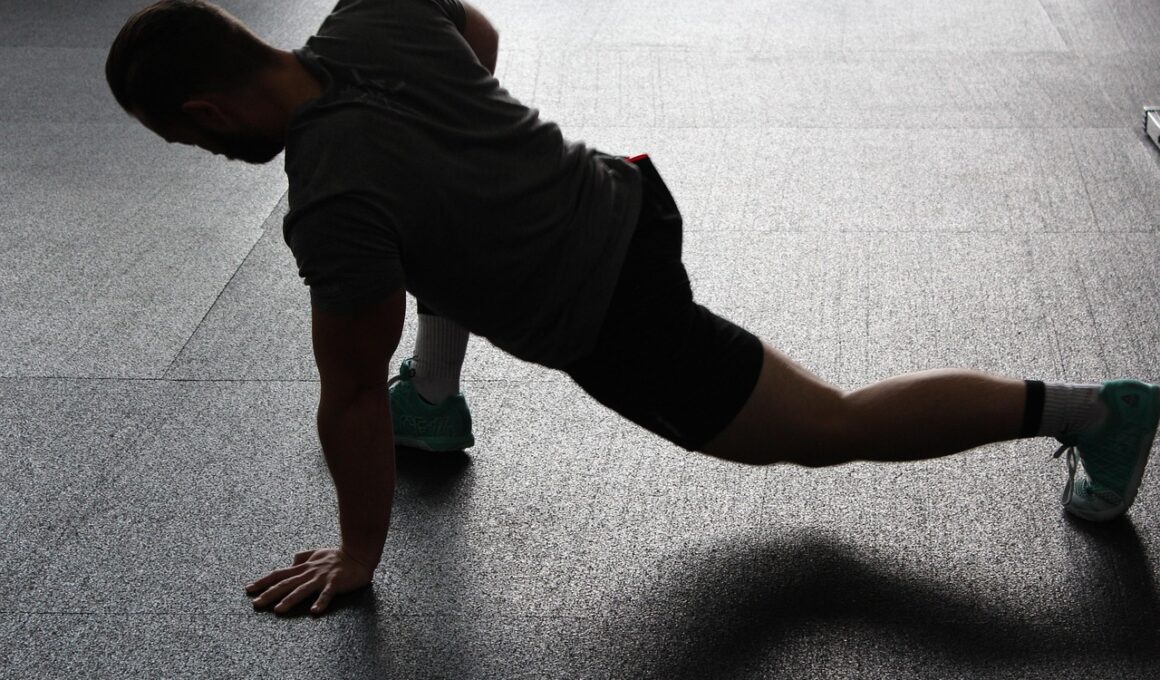Boxing Warm-Up Routines to Prevent Injuries
Starting a boxing routine without proper warm-ups can lead to serious injuries. Warming up is essential as it prepares your body for the physical demands of boxing. A good warm-up increases blood flow to your muscles, ensuring they are ready for action. It also enhances joint mobility, reducing the risk of strains and sprains. Including dynamic stretches and movements in your warm-up routine can improve your performance significantly. They help in gradually raising your heart rate, which is crucial for preventing injuries. It’s advisable to start with light cardio activities like jumping jacks to elevate your heart rate. Incorporating stretches for your shoulders, hips, and legs also adds value. Aim for at least 10-15 minutes of warming up. This practice not only prevents injuries but also aids in better muscle recovery post-training. Engaging in a detailed warm-up routine can set the tone for your boxing session. Always listen to your body and adjust your warm-ups accordingly. Remember, investing time in warming up is crucial for all boxing enthusiasts, regardless of skill level.
One essential component of your warm-up routine should be dynamic stretches. Unlike static stretching, dynamic exercises help to actively loosen up muscles and tendons. Effective dynamic stretches for boxers include arm circles and torso twists. You may also incorporate leg swings and high knees. These movements help improve your range of motion and prepare your muscle tissues for the strain of boxing. Integrating footwork drills into your warm-up can also be very beneficial. It enhances agility and coordination while allowing your muscles to gradually adapt to more responsive movements. Aim to perform footwork drills, such as shuffles and pivots, for several minutes as part of your routine. Additionally, don’t forget to focus on your upper body. Shadow boxing is an excellent way to engage multiple muscle groups and warm up your shoulders, arms, and core. This practice mimics actual boxing movements, promoting muscle memory. Remember to keep your movements fluid and controlled. Each exercise should be performed mindfully to maximize effectiveness. A well-rounded warm-up can enhance your ability to box safely and efficiently.
Incorporating Cardio into Your Warm-Up
Incorporating cardiovascular exercises into your warm-up is equally crucial for boxing. A strong cardio session enhances endurance and prepares your cardiovascular system for the workout ahead. Engage in activities like skipping rope, jogging in place, or using a treadmill. These exercises help in getting your heart rate up, which is an essential component for effective warm-ups. Aim for about 5-10 minutes of moderate-intensity cardio at the start. In addition, skipping rope is particularly effective for boxers. Not only does it help in agility, but it also conditions your legs. Alternating between fast and slow jumps can create a diversity in your warm-up intensity. If you prefer jogging, do so in intervals, mixing light pace with faster bursts. Keep your movements rhythmic and ensure that your breathing is steady. This combination will make a significant difference during sparring or heavy bag work. As you finish, gradually lower the intensity to signal your body to prepare for the techniques to follow. Focusing on cardio helps ensure that no parts of your body are neglected. Are you ready to take your boxing warm-ups seriously?
A proper warm-up also engages your core muscles, which are vital in boxing. Core stability is essential for balance and good technique during punches and defensive movements. Include exercises like planks and Russian twists as part of your warm-up routine. Not only do these exercises activate your core, but they also improve your posture and prevent potential injuries. Aim to hold each plank for 30 seconds to a minute while performing multiple sets. You can alternate this with dynamic movements to keep your heart rate elevated. Another beneficial core exercise is the medicine ball throw. This technique mimics the explosive movements necessary in boxing and can also be a fun addition to your warm-up. Be sure to integrate rotational exercises that target your obliques for well-rounded core engagement. A strong core contributes to more powerful and effective punches. Continuous engagement in these routines can lead to noticeable improvements in your performance. Make your warm-up as comprehensive as possible by targeting all muscle groups. The aim is not only to prepare your body physically but also mentally.
Flexibility and Mobility Drills
In addition to the above, practicing flexibility and mobility drills is paramount in any boxing warm-up routine. Increasing flexibility enhances your range of motion, allowing for more fluid movements when you’re in the ring. Techniques such as leg stretches and calf raises help in achieving this goal. Start with basic stretches, paying close attention to your hamstrings and quadriceps. Incorporate yoga-inspired movements like sun salutations to enhance overall flexibility. Both your upper and lower body require attention during your warm-up. Make sure to include wrist and ankle mobility exercises as well. These small joints bear the brunt of boxing activities. In addition, involve foam rolling or gentle self-myofascial release to release tension in your muscles. This method can greatly assist in muscle recovery and reduce soreness after intense training. Ideally, your warm-up routine should seamlessly transition from dynamic moves to more static stretches that focus on flexibility. Regularly practicing these techniques will drastically improve your overall boxing performance while minimizing injury risks. Consistency in flexibility training will serve you well on your boxing journey.
Finally, ensuring proper hydration and nutrition is another critical aspect often overlooked in warm-up routines. Your body needs to be well-fueled and hydrated to perform optimally. Drinking water before starting your warm-up aids in maintaining your hydration levels. Consuming a light snack, like a banana or a protein bar, can provide the necessary energy boost. These pre-training rituals should not be neglected if you wish to maximize your boxing potential. Moreover, understanding your body’s nutritional needs can further enhance your training performance. Take note of what foods make you feel energetic; utilize that information to plan your meals accordingly. Establishing a routine surrounding your pre-training nutrition can foster consistency and improvement. Avoid heavy meals immediately before working out, as they may lead to discomfort during training. Regularly refueling your body with the right nutrients aids in muscle recovery. Don’t forget to monitor your hydration levels throughout your workout. It’s helpful to include electrolytes, especially during extended training. In essence, boxers must recognize the importance of combining proper nutrition and hydration within their warm-up routine for maximum efficiency.
Conclusion: Consistency is Key
In summary, implementing effective boxing warm-up routines can greatly reduce the chances of injuries while enhancing performance. Focusing on dynamic stretches, cardio, core stability, flexibility, mobility drills, and proper nutrition plays a crucial role. Consistency is key in achieving the best results. Regularly practicing these components in your warm-ups ensures that your body becomes accustomed to the rigors of boxing. Be mindful of how your body responds to different exercises and adjust accordingly. As you refine your warm-up routine, you will likely notice improvements in your overall capabilities in the ring. This proactive approach to boxing will not only enhance your skills but also ensure that you perform safely. Make these warm-ups an integral part of each training session. Adopting a thoughtful approach will pay dividends in your boxing journey. Remember, a good warm-up sets the tone for the entire workout, allowing you to push harder without fearing injuries. Dedicate time to your warm-up, and make it a ritual. With these practices in place, you are ready to tackle the challenges ahead confidently and effectively.





